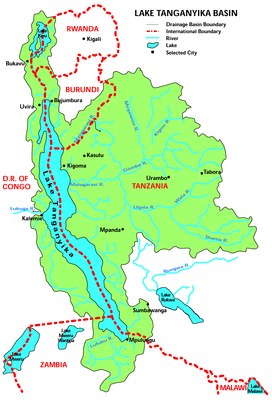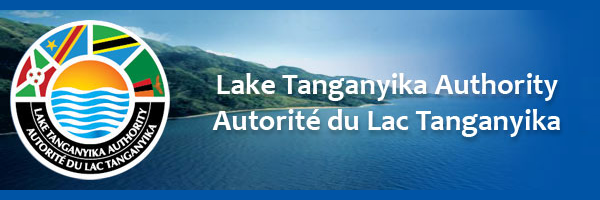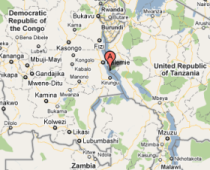Lake & Basin
Facts about the Lake Basin
 Lake Tanganyika and its Basin are endowed with exceptionally large and highly diverse heritage of flora and fauna. The lake is a global hotspot of biodiversity, and an extremely valuable aquatic ecosystem containing almost 17% of the global available surface freshwater supply and some of the largest freshwater fisheries on the African continent. Estimates suggest that Lake Tanganyika harbours at least 1500 species out of which approximately 600 are currently considered endemic to the lake. In addition to Lake Tanganyika’s elevated levels of aquatic biodiversity, the Basin is renowned for its terrestrial biodiversity and scenic beauty. The Basin contains several forest reserves and national parks including Rusizi Nature Reserve and Kigwena Forest Reserve in Burundi, Gombe Stream, Katavi and Mahale Mountains National Park in Tanzania, and Nsumbu National Park in Zambia. The lake and its Basin provide a diverse range of ecosystem services that sustain the livelihoods of millions of people.
Lake Tanganyika and its Basin are endowed with exceptionally large and highly diverse heritage of flora and fauna. The lake is a global hotspot of biodiversity, and an extremely valuable aquatic ecosystem containing almost 17% of the global available surface freshwater supply and some of the largest freshwater fisheries on the African continent. Estimates suggest that Lake Tanganyika harbours at least 1500 species out of which approximately 600 are currently considered endemic to the lake. In addition to Lake Tanganyika’s elevated levels of aquatic biodiversity, the Basin is renowned for its terrestrial biodiversity and scenic beauty. The Basin contains several forest reserves and national parks including Rusizi Nature Reserve and Kigwena Forest Reserve in Burundi, Gombe Stream, Katavi and Mahale Mountains National Park in Tanzania, and Nsumbu National Park in Zambia. The lake and its Basin provide a diverse range of ecosystem services that sustain the livelihoods of millions of people.
Environmental degradation caused mainly by human induced activities poses serious threats to the biodiversity and sustainable use of the natural resources in the Lake Tanganyika Basin. In recognition of these threats, the four riparian countries of Burundi, Democratic Republic of Congo, Tanzania and Zambia with support from international partners convened the first international scientific conference on the conservation of biodiversity of Lake Tanganyika and its Basin in 1991. One of the main outcomes of this conference was that international funding agencies were attracted. Between 1992 and 2003 the riparian countries and supporting partners jointly implemented the Lake Tanganyika Research Project (LTR), the Lake Tanganyika Biodiversity Project (LTBP) and the Lake Tanganyika Management Planning Project
Hotspot of Biodiversity
Lake Tanganyika is internationally recognised as a global hotspot of biodiversity, representing some of the most diverse aquatic ecosystems in the world (Groombridge and Jenkins, 1998). The lake’s valuable aquatic ecosystem and the many natural resources found in its Basin provide essential sources of livelihood and income for over 10 million riparian population around the lake, and contribute to the growing economies of surrounding countries of Burundi, Democratic Republic of Congo (DR Congo), Tanzania and Zambia.
 Estimates suggest that Lake Tanganyika harbours at least 1500 species (Coulter, 1991), although species numbers vary according to taxonomic authority. Approximately 600 species are endemic to the lake, including 245 morphologically diverse and colourful cichlid fish species (Snoeks, 2000; Genner et al., 2004). Lake Tanganyika is unique in harbouring endemic species clusters of bagrids, cyprinids, mastacembelids, and mochokids (Coulter, 1991; Vreven, 2005; Day & Wilkinson, 2006). Moreover, a large diversity of endemic ostracods, gastropods, shrimp, crabs (e.g., Martens, 1994; West et al., 2003; Marijnissen et al., 2004; Fryer 2006), as well as many other taxa can be found in Lake Tanganyika. The lake is valuable not only for the presence of these unique species, but also as a microcosm in which to study the processes of evolution that have led to this diversity.
Estimates suggest that Lake Tanganyika harbours at least 1500 species (Coulter, 1991), although species numbers vary according to taxonomic authority. Approximately 600 species are endemic to the lake, including 245 morphologically diverse and colourful cichlid fish species (Snoeks, 2000; Genner et al., 2004). Lake Tanganyika is unique in harbouring endemic species clusters of bagrids, cyprinids, mastacembelids, and mochokids (Coulter, 1991; Vreven, 2005; Day & Wilkinson, 2006). Moreover, a large diversity of endemic ostracods, gastropods, shrimp, crabs (e.g., Martens, 1994; West et al., 2003; Marijnissen et al., 2004; Fryer 2006), as well as many other taxa can be found in Lake Tanganyika. The lake is valuable not only for the presence of these unique species, but also as a microcosm in which to study the processes of evolution that have led to this diversity.
Environmental challenges
 The Lake Tanganyika Basin faces multiples challenges, resulting from the activities of rapidly expanding human populations in the riparian countries. The most immediate threats are:
The Lake Tanganyika Basin faces multiples challenges, resulting from the activities of rapidly expanding human populations in the riparian countries. The most immediate threats are:
- Unsustainable agricultural practices and deforestation, resulting in erosion and excessive sediment and nutrient loads
- Indutrial and urban pollution (including boats discharges)
- Overexploitation of the lake's fish stocks
- Invasive species
- Effects of global climate change
The transboundary environmental problems in Lake Tanganyikabasin have the potential to impact the livelihoods of millions people.
Document Actions













